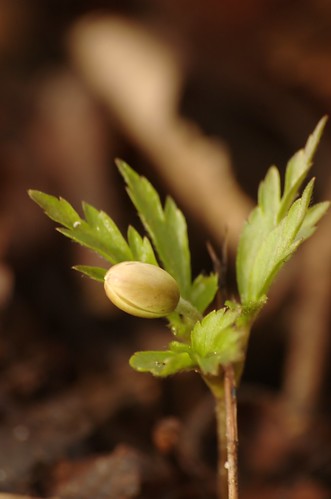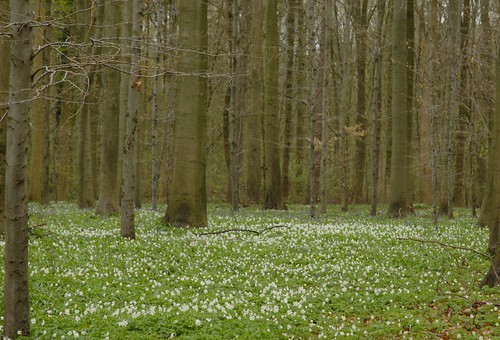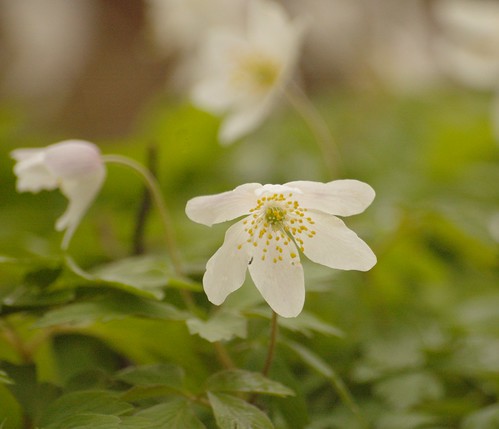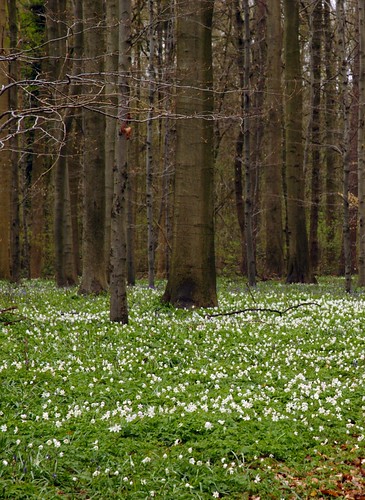Eén van de mooiste verrassingen die ik ontdekte toen ik rond 15 maart (garden bloggers bloom day) de tuin doorzocht op zoek naar bloeiende planten, was dit eerste voorzichtige knopje van de bosanemoon.

Ik heb al verschillende keren geprobeerd om de bosanemoon in de tuin te planten, maar het bloempje groeit het liefst op oude bosgrond, met flinke laag oude bladaarde.
Toen we hier pas woonden, probeerde ik de anemoontjes te planten onder de beuken, en daar zie ik elk jaar wel een paar blaadjes opduiken, maar bloemen – ho maar!.
Die beuken zijn immers wel oud, maar de vorige eigenaars hadden de grond onder de bomen wel heel ‘proper’ gehouden, en van een strooisellaag was dus geen sprake.
Een paar jaar later probeerde ik mijn geluk onder de meidoornhaag, maar daar kreeg ik hetzelfde verhaal: wel elk jaar twee of drie blaadjes, maar geen bloemen.

En dit keer plantte ik ze in ‘de nieuwe bosrand’, een strook van ongeveer 10 x 30 m² waar we vlak na de aankoop van de tuin allerlei inheemse bomen en struiken plantten.
Die bosrand is nu dus zo’n 15 jaar oud, en blijkbaar kan de strooisellaag de bosanemoontjes nu wel bekoren: niet alleen blijken de plantjes zich te hebben uitgebreid, maar bovendien zitten er knopjes in…
Kan je geloven dat het voor mij een ontroerende ervaring was, om die tere knopjes tussen het groene blad te ontdekken?
She likes our grove!
The most beautiful surprise my garden was hiding, when I was searching for blooms in preparation for this month’s Garden Bloggers Bloom Day, was the little budding Wood anemone flower you see on the picture in the Dutch part of this post (scroll up).

Wood Anemone is native in Flanders (Dutch speaking part of Belgium), and is even considered an ‘indicator-plant’ for old woods. In the Netherlands however, you can find the plant in several parts of the country, but it is only native in Limburg, the south-eastern part of the country, in between Belgium and Germany. In other regions it is a ‘stinzenplant’, a plant introduced in the past centuries in parks and gardens surrounding some manors (‘stins’ means ‘house made of stone’), and from there it naturalized.
Since we live here, I have tried to introduce the Wood Anemone before, but never succeeded.
The plant prefers a soil covered with a thick layer of well established leave-mould.
When we just moved to this place, I planted a Wood Anemone under our beeches. And yes, our beeches are old, but no leave-mould underneath them, since the previous owner had kept the place rather ‘clean’. The plant hasn’t gone, it shows two or three leaves every year, but that’s it.
A few years later, I tried planting it underneath the hawthorn hedge, but it was a failure again. Some years I see some leaves, but I never had a single flower.

This time, I gave them a place in the ‘new grove’ at the far end of our garden.
(‘The old grove’ is a strip of birches that were planted 10 years before we bought the house and the garden. ‘The new grove’ is a strip (10m x 30m, just a little bit more than 300 square yards) just in front of the old grove, that we planted shortly after acquiring the garden, and that consists of a mixture of native shrubs and trees.)
This grove is 15 years old now, and the soil seems to be acceptable for this picky little flower, since it is not only spreading, but it even has two flower-buds.
Can you believe I was almost moved to tears, when I discovered those delicate white buds between the tender foliage?
Beautiful pictures. The woods with white ones are wonderful.
Zo zie je maar weer dat de aanhouder wint en het is inderdaad een plaatje om te zien.
Wat geweldig dat het je nu toch gelukt is. En ja, die ontroering begrijp ik helemaal. Prachtig die foto van het Hallerbos vol bosanemoontjes! In mijn vorige tuin had ik ze gewoon in de border geplant en daar deden ze het ook nog. Stom beginnersgeluk zullen we maar zeggen. 😉
Ik vind het een enorm mooi bloemetje. Hier in zuid limburg treffen we ze ook wel aan, maar het is iedere keer zoeken en op de juiste tijd zijn.
I can understand your tears completely and am very happy for your discovery! Beautiful pictures of the woods too.
Ik dacht dat het Hallerbos vooral bekend was voor zijn Boshyacinten… Maar goed, Bosanemoon zal er ook wel staan. Fijn te lezen dat je ze eindelijk hebt ontdekt in je tuin!
Yes, I can surely believe it and would be so moved too. It is wonderful.
Van Harte, wat een prachtige verrassing! En wat leuk een Garden Bloggers Bloom Day. Ik hoop dat ik volgend jaar mee kan doen.
Bij ons in de Randstad heb je veel bosanemonen in het Haagse Bos, ze geven een hele mooie witte gloed. Er zijn ook boshyacinten voor de lila gloed. Maar idd zijn dat stinzenplanten.
Ik hoop dat je nog lang plezier van ze hebt!
@Raingardener, Dreamybee: those woods are most famous – as Nico mentioned – for their bluebells. But a little bit earlier than the bluebells, the ‘windflowers’, Wood Anemones, are there.
@fluitenkruid, Me!: bedankt voor jullie bezoekje…
@Yolanda Elisabet: en hoe doe je dat met de openvallende plaats als de bosanemoontjes weer verdwenen zijn? Of komt daar iets in de plaats dat pas heel laat boven de grond komt?
@Nico: toen wij in het Hallerbos waren, was het nog een tikkeltje te vroeg voor de wilde hyacintjes. Hoewel: als je goed kijkt zie je op de laatste foto helemaal vooraan al een paar stipjes!
@tina: thanks for visiting!
@Middenloo: Die Garden Bloggers Bloom day is elke maand op de 15de! Dus wellicht kan je ergens dit jaar nog inpikken!
Bosanemoontjes, daar moet ik me de eerste vijf jaar nog niet aan wagen denk ik. Maar je post geeft me wel een antwoord op een vraag die ik me al een poosje stel: om een bepaalde plant te introduceren, hoeveel stekjes moet je er daar van aanplanten? 2? 5? 10? Tot nu toe ging het bij mij nogal moeizaam, al is het ondertussen toch met een aantal soorten (onder andere de donkere ooievaarsbek die ik van Yo kreeg) wel gelukt. Bij jou lukt het blijkbaar met een paar exemplaren. Dat opent perspectieven 🙂
The Anemone nemorosa is a charming little woodland flower. It looks very effective as a lovely clump under the trees. How satisfying it must be to have them established and budding now. Soon, you will have your own patch of white in the woods.
Anne, YES, I can see why you would be moved to tears! The photo at the nursery is amazing…wow…the thought that you might have something even close to that is tempting, I would want them too. And now, to see even a blossom or two, how wonderful~It almost looks like ‘Hepatica’, which is also a ‘woodsy’ flower, a lovely little flower like your wood=Anemone. Anyway, congratulations on this success!! Hopefully, you will see many more popping up and blossoming!
How excellent to have found a potentially good site for a beautiful wildflower.
We have a similar wood anemone (A. lancifolia) that grows in rich cove forests and basic-mesic forests in the Southeastern U.S. It’s not in cultivation much as far as I know, probably because it’s fussy, too!